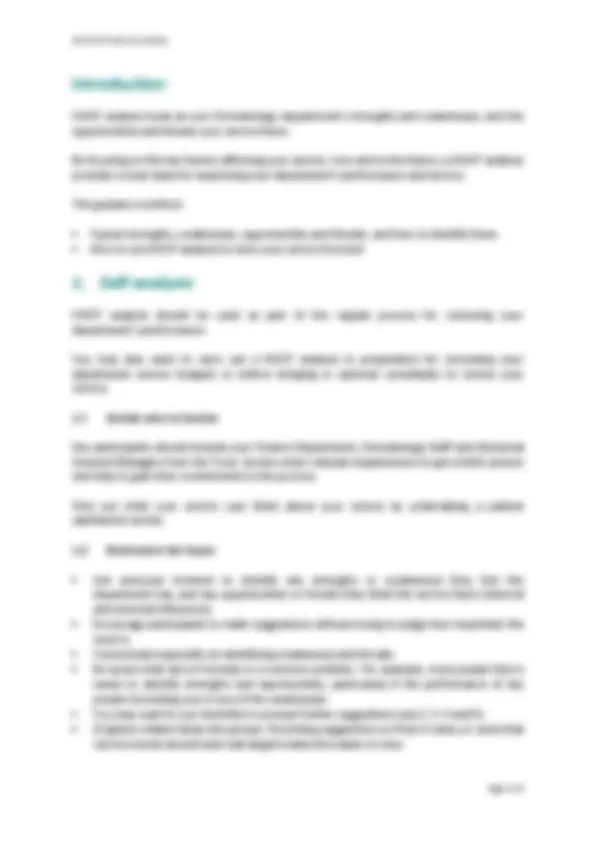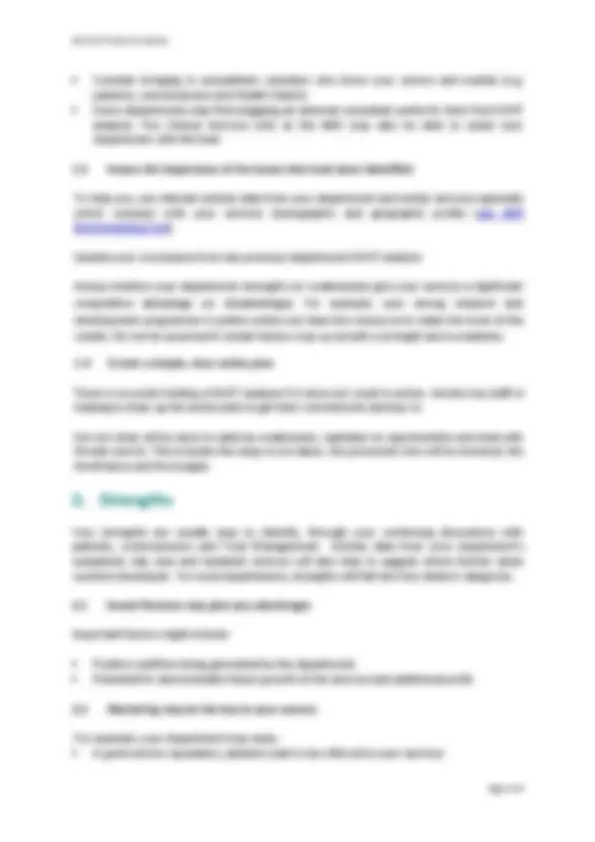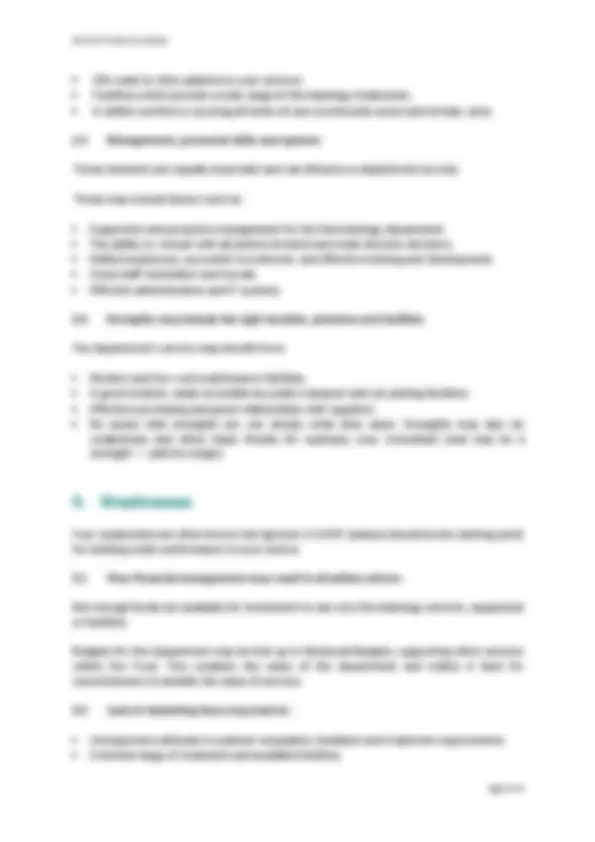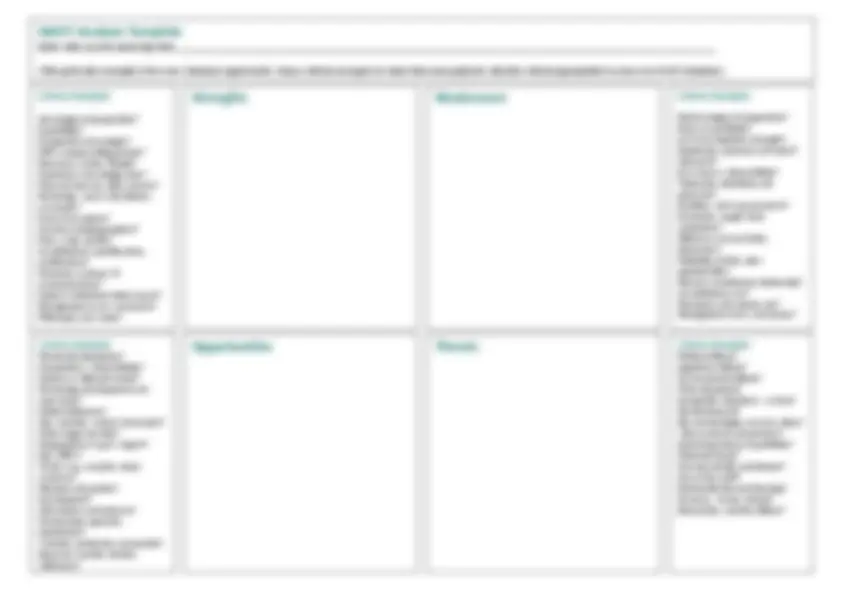







Study with the several resources on Docsity

Earn points by helping other students or get them with a premium plan


Prepare for your exams
Study with the several resources on Docsity

Earn points to download
Earn points by helping other students or get them with a premium plan
Community
Ask the community for help and clear up your study doubts
Discover the best universities in your country according to Docsity users
Free resources
Download our free guides on studying techniques, anxiety management strategies, and thesis advice from Docsity tutors
Guidance for skin care products in creating swot analysis
Typology: Summaries
1 / 9

This page cannot be seen from the preview
Don't miss anything!






SERVICE GUIDANCE
Consider bringing in sympathetic outsiders who know your service and market (e.g. patients, commissioners and Health Watch). Some departments may find engaging an external consultant useful for their first SWOT analysis. The Clinical Services Unit at the BAD may also be able to assist your department with this task.
1.3 Assess the importance of the issues that have been identified
To help you, use relevant activity data from your department and similar services regionally which compare with your services demographic and geographic profile (see NHS Benchmarking Tool).
Update your conclusions from any previous department SWOT analysis.
Assess whether your department strengths (or weaknesses) give your services a significant competitive advantage (or disadvantage). For example, your strong research and development programme is useless unless you have the resources to make the most of the results. Do not be surprised if certain factors crop up as both a strength and a weakness.
1.4 Create a simple, clear action plan
There is no point holding a SWOT analysis if it does not result in action. Involve key staff in helping to draw up the action plan to get their commitment and buy-in.
Set out what will be done to address weaknesses, capitalise on opportunities and deal with threats (see 6). This includes the steps to be taken, the personnel who will be involved, the timeframes and the budget.
2. Strengths
Your strengths are usually easy to identify, through your continuing discussions with patients, commissioners and Trust Management. Activity data from your department’s outpatient, day case and inpatient services will also help to suggest where further areas could be developed. For most departments, strengths will fall into four distinct categories.
2.1 Sound finances may give you advantages
Important factors might include:
Positive cashflow being generated by the department. Potential for demonstrable future growth of the services and additional profit.
2.2 Marketing may be the key to your success
For example, your department may enjoy: A good service reputation, patients want to be referred to your services
GPs want to refer patients to your services. Facilities which provide a wide range of Dermatology treatments. A skilled workforce covering all levels of care (community acute and tertiary care).
2.3 Management, personnel skills and systems
These elements are equally important and can influence a department success.
These may include factors such as:
Supportive and proactive management for the Dermatology department. The ability to consult with all parties involved and make decisive decisions. Skilled employees, successful recruitment, and effective training and development. Good staff motivation and morale. Efficient administration and IT systems.
2.4 Strengths may include the right location, premises and facilities
The department’s service may benefit from:
Modern and low-cost maintenance facilities. A good location, easily accessible by public transport and car parking facilities. Effective purchasing and good relationships with suppliers. Be aware that strengths are not always what they seem. Strengths may also be weaknesses and often imply threats for example; your Consultant Lead may be a strength — until he resigns.
3. Weaknesses
Your weaknesses are often known but ignored. A SWOT analysis should be the starting point for tackling under performance in your service.
3.1 Poor financial management may result in situations where:
Not enough funds are available for investment in any new Dermatology services, equipment or facilities.
Budgets for the department may be tied up in Divisional Budgets, supporting other services within the Trust. This weakens the value of the department and makes it hard for commissioners to identify the value of services.
3.2 Lack of marketing focus may lead to:
Unresponsive attitudes to patient complaints, feedback and treatment requirements. A limited range of treatment and available facilities.
Social developments; for example, demographic changes or changing patient needs leading to an increase in demand for your service. New technology; for example, new treatment therapies and information technology.
5. Threats
Threats can be minor or could possibly destroy the business.
5.1 Changes involving organisations and individuals that directly affect your service can have far-reaching effects
For example:
The commissioning of new services and providers within your service locality. Loss of a significant patient referrals Failure by new providers to meet their service specification requirements, (cherry picking and mismanagement of patients). Locally agreed tariffs with commissioners which do not cover treatment costs. Skilled staff leaving with key knowledge for the department. No recruitment being undertaken to replace key staff before they leave the department.
6. Action
The results of SWOT analysis — and the action needed — may be different for every department.
6.1 Capitalise on opportunities that play to your service strengths
Opportunities that match your service strengths may prompt the department to follow a strategy of expansion.
The SWOT analysis may also suggest other strategic options for example:
Moving away from areas of significant threat to more promising opportunities. Focusing on turning around service weaknesses in areas of significant opportunity. Taking defensive measures in areas of threat where the service is weak.
6.2 Address your weaknesses
Decide which weaknesses need to be addressed first. Other weaknesses must be acknowledged and respected until time and resources allow a solution.
Some weaknesses have a clear solution. For example, services weakness might be solved by recruiting new personnel to expand the service and increase income.
Some weaknesses will take time and money to address. For example, you may need to start a programme of improvements through investment, recruitment, training, or quality management.
6.3 Protect your department against threats
For example:
Build relationships with GPs, commissioners, the public and patients. Promote good employee relations. Make sure you have clear and reasonable service contracts with commissioners. Draw up realistic contingency plans to cope with possible crises.